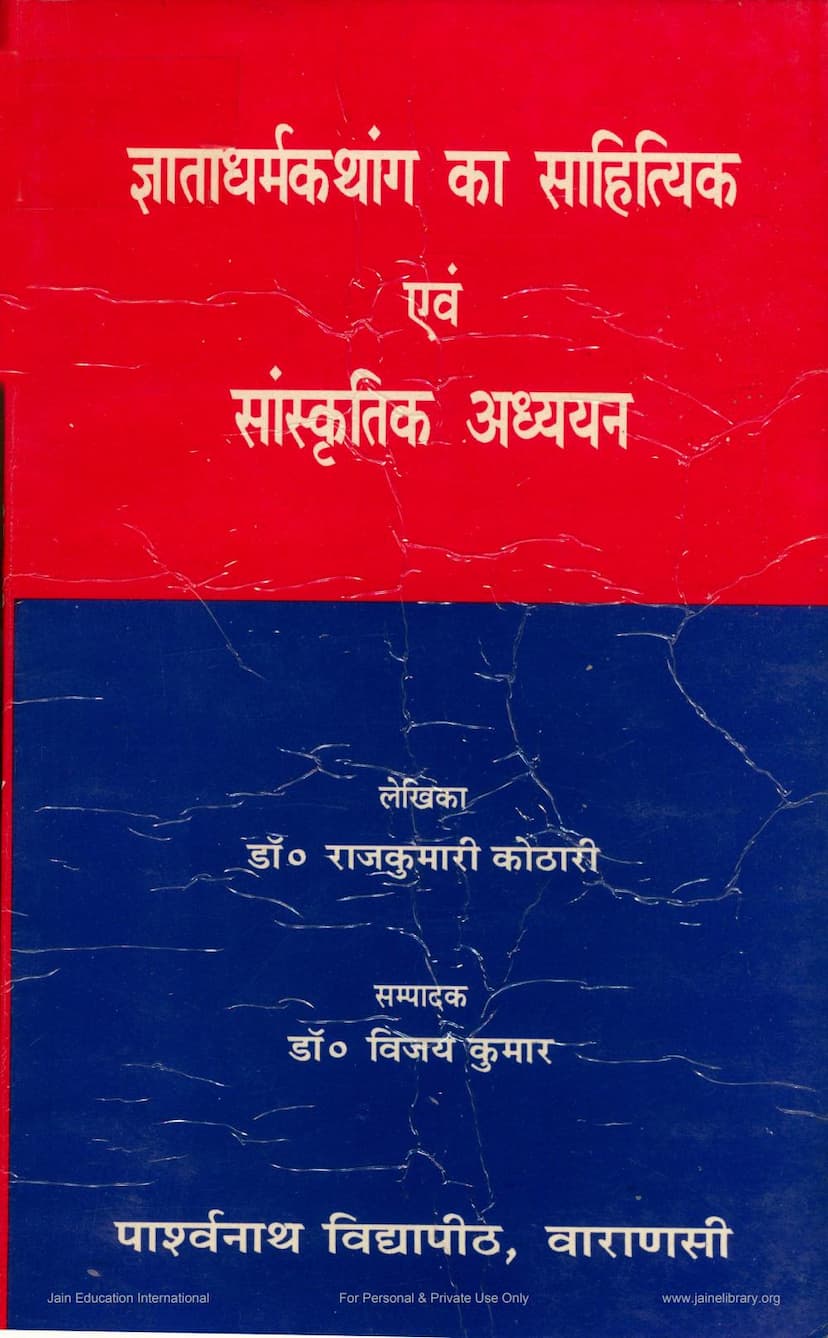Gnatadharmkathang Ka Sahityik Evam Sanskrutik Adhyayan
Added to library: September 1, 2025

Summary
Here's a comprehensive summary of the Jain text "Gnatadharmkathang ka Sahityik evam Sanskrutik Adhyayan" (Literary and Cultural Study of Gnatadharmakathang) by Dr. Rajkumari Kothari, edited by Dr. Vijay Kumar:
This book provides an in-depth literary and cultural analysis of the Jnatadharmakathang (also known as Nayatadhammakao), a significant canonical text within Jain Agam literature. The author, Dr. Rajkumari Kothari, embarks on a detailed exploration of this scripture, aiming to highlight its literary merits and its rich repository of cultural information pertaining to ancient India.
Key aspects covered in the book:
- Introduction to Jain Agamas: The book begins by contextualizing the Jnatadharmakathang within the broader framework of Jain Agamic literature. It discusses the origin, nature, linguistic diversity (primarily Prakrit), and the classification of these sacred texts. The importance of Prakrit as the progenitor of many modern Indian languages is also emphasized.
- Significance of Jnatadharmakathang: The text is identified as the sixth Anga among the twelve canonical Angas of Jainism. It is highlighted as a foundational work in Jain narrative literature. The author emphasizes its role in presenting complex spiritual and ethical doctrines through engaging stories.
- Structure and Content: The Jnatadharmakathang is divided into two Shrutakandhas (sections). The first Shrutakandhas comprises nineteen narratives, often referred to as "Gnata" or "Gnata studies," that focus on moral and ethical teachings illustrated through stories. The second Shrutakandhas contains ten sections, dealing with religious narratives and the lives of various individuals, particularly celestial beings and their rebirths. The book meticulously analyzes the subject matter of each narrative, presenting them in a clear and accessible manner, often highlighting the core message or "soul" of each story.
- Literary Analysis: The book delves into the literary aspects of the Jnatadharmakathang, examining its:
- Narrative Structure (Kathanak): The plots are analyzed for their social, historical, political, psychological, and spiritual dimensions. The intricate weaving of main and sub-plots is discussed.
- Character Portrayal (Charitra-chitran): The book examines the depiction of characters, ranging from kings and princes to commoners, celestial beings, and animals. It highlights how characters are presented to convey moral lessons and the underlying psychological nuances.
- Dialogue (Kathopkathan): The effectiveness of dialogues in advancing the plot, revealing character, and conveying teachings is analyzed.
- Setting (Desh-Kaal): The description of geographical locations, cities, environments, and the socio-historical context is explored to understand the cultural milieu.
- Language and Style (Bhasha-Shaili): A significant portion of the book is dedicated to linguistic analysis, examining the Prakrit language used, its grammatical features, vocabulary, use of native words (deshi shabda), figures of speech (alankaras), and stylistic devices. The archaic nature of the language and its connection to the evolution of Indian languages are discussed.
- Purpose (Uddeshya): The underlying objectives of the narratives, which primarily aim at moral upliftment, spiritual guidance, and the dissemination of Jain principles, are elucidated.
- Cultural Significance: The book places a strong emphasis on the cultural insights gleaned from the Jnatadharmakathang. It reconstructs the socio-cultural landscape of ancient India by analyzing:
- Social Life: The book details aspects of social structure, including the varna system, family life, marriage customs, the status of women, dietary practices, festivals, and entertainment. The prevalence of customs like the slave system and the role of courtesans are also noted.
- Political System: Insights into the administrative structure, the role of kings, ministers, succession, and justice systems are drawn from the narratives.
- Economic Life: The text sheds light on prevalent occupations like agriculture, trade, crafts, and various industries, providing details about modes of transport, markets, and economic transactions.
- Arts and Sciences: The book highlights the knowledge of various arts and sciences, including architecture, sculpture, music, dance, drama, and a wide range of 72 arts for men and 64 arts for women mentioned in the text. The educational system and the importance of acquiring knowledge are also discussed.
- Religious Beliefs and Practices: The study explores the religious life, including the adherence to vows (anuvrata, mahavrata), rituals, the worship of deities, and the philosophical underpinnings of Jainism. The coexistence and interactions with other religious traditions are also touched upon.
- Geographical Landscape: The text provides descriptions of cities, regions, rivers, mountains, and forests, offering a glimpse into the geography of ancient India.
- Detailed Analysis of Narratives: The book provides a chapter-by-chapter (or rather, study-by-study) breakdown of the nineteen stories in the first Shrutakandhas. Each story is summarized, and its literary and cultural significance is discussed. This includes identifying the moral lessons, the historical or legendary figures involved, and any specific social or cultural practices depicted. Examples include the stories of Meghakumar, Dhanna and Vijay the thief, Rohini, Malli Kumari, Draupadi, and others.
- Manuscripts and Published Editions: The book also touches upon the various manuscripts of the Jnatadharmakathang and its different published editions and commentaries, underscoring the scholarly efforts to preserve and study this ancient text.
- Conclusion: The book concludes by reiterating the profound literary and cultural value of the Jnatadharmakathang. It positions the text as a crucial source for understanding Jain philosophy, ethics, and the socio-cultural history of ancient India, highlighting its continued relevance for contemporary society.
In essence, Dr. Kothari's work is a scholarly endeavor to illuminate the Jnatadharmakathang, showcasing its multifaceted contribution to Jain literature and Indian culture, making it an invaluable resource for scholars and students of Jainism and ancient Indian studies.